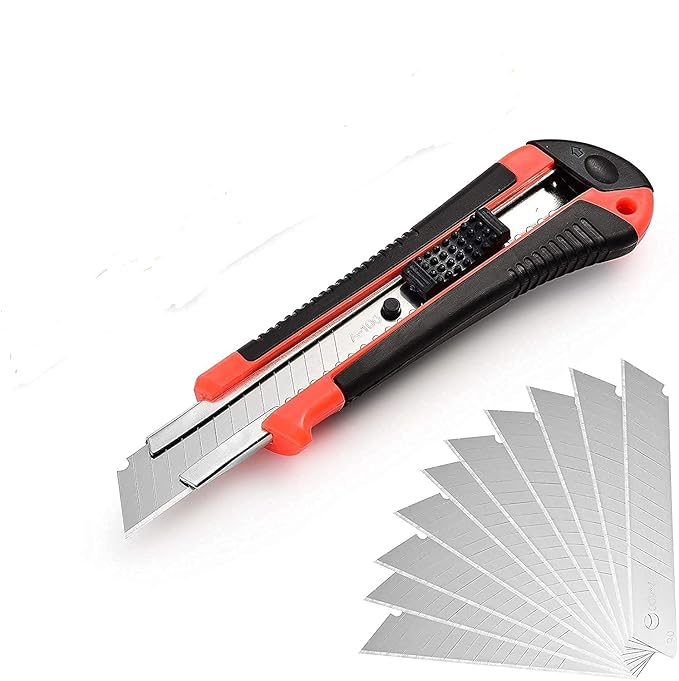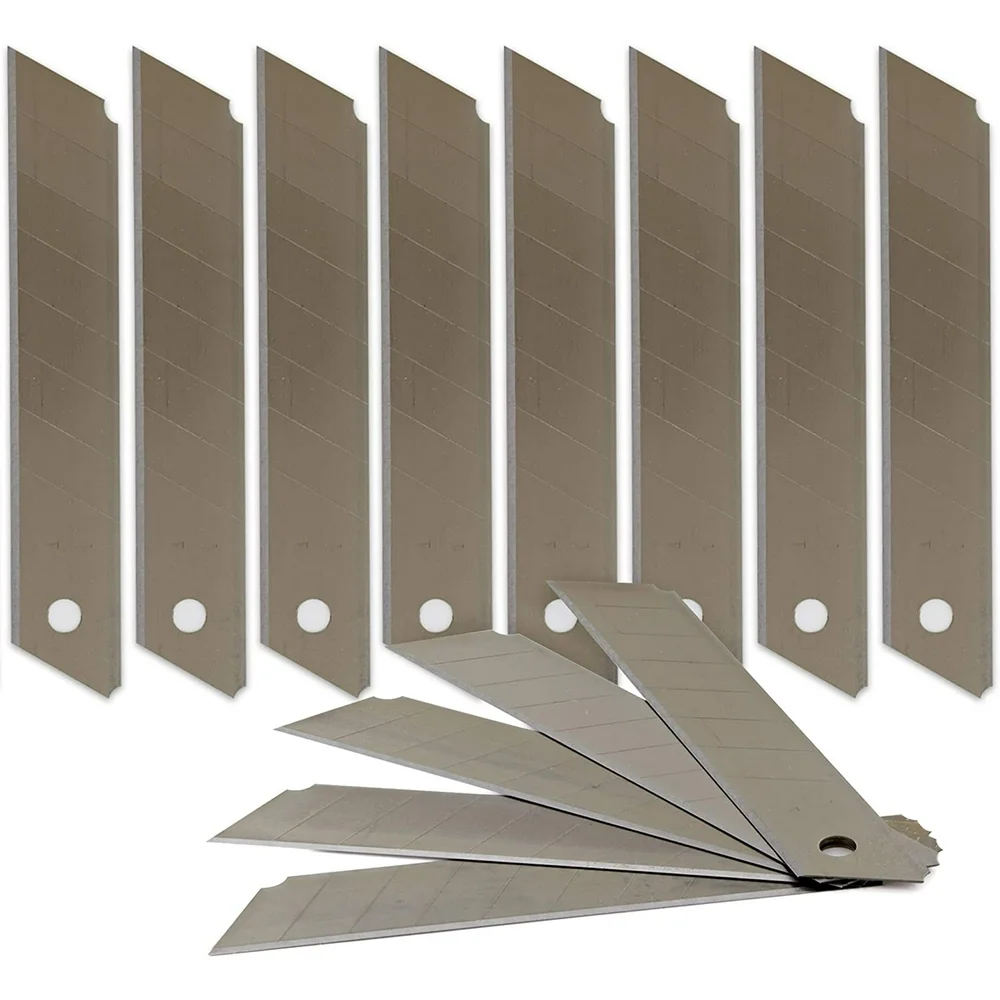Cutter knife blades are essential tools in various industries, from construction to crafting. Proper maintenance and care can significantly extend their lifespan, ensuring they remain effective and safe to use. This article will explore various strategies for maintaining and extending the lifespan of your cutter knife blades, organized into clear sections for easy reference.
Understanding Cutter Knife Blades
Types of Cutter Knife Blades
Cutter knife blades come in various types, each designed for specific tasks. Common types include utility blades, box cutter blades, and specialty blades for specific materials. Utility blades are versatile and can be used for general cutting tasks, while box cutter blades are specifically designed for opening packages and cutting through cardboard. Specialty blades, such as those designed for cutting carpet or linoleum, have unique shapes and materials that enhance their performance for specific applications. Understanding the type of blade you are using is crucial for effective maintenance, as each type may require different care techniques to ensure optimal performance.
Importance of Blade Maintenance
Regular maintenance of cutter knife blades is vital for several reasons. It enhances performance, ensures safety, and reduces the need for frequent replacements. A well-maintained blade cuts more efficiently, which can save time and effort in any task. Additionally, maintaining your blades can prevent accidents caused by dull or damaged blades, which can slip or break during use. By investing time in proper maintenance, you not only extend the life of your tools but also improve the quality of your work, leading to better results and increased satisfaction in your projects.
Basic Maintenance Practices
Cleaning Your Blades
Keeping your cutter knife blades clean is the first step in maintenance. After each use, wipe the blade with a soft cloth to remove debris and moisture. For tougher stains, a mild detergent can be used. Avoid abrasive cleaners that can scratch the blade surface, as these scratches can lead to rust and affect the blade's cutting ability. Regular cleaning not only keeps the blade looking new but also prevents the buildup of materials that can cause corrosion over time. Additionally, consider using a rust inhibitor or oil to coat the blade after cleaning, providing an extra layer of protection against moisture and rust.
Drying the Blades
Moisture can lead to rust and corrosion, which can damage the blade. After cleaning, ensure that the blade is thoroughly dried. Store the blades in a dry environment to prevent moisture accumulation. If you live in a humid area, consider using silica gel packets in your storage area to absorb excess moisture. Proper drying techniques are essential, as even small amounts of moisture can lead to significant damage over time. By taking these precautions, you can maintain the integrity of your blades and ensure they remain sharp and effective for longer periods.
Sharpening Techniques
When to Sharpen
Knowing when to sharpen your cutter knife blades is essential. Signs that a blade needs sharpening include difficulty in cutting, frayed edges, or visible dullness. Regularly inspect your blades to determine when they require sharpening. It is advisable to develop a routine for checking your blades, perhaps after every few uses or at the end of each workday. This proactive approach can help you catch dull blades before they affect your work quality. Additionally, consider keeping a sharpening schedule based on the frequency of use, as more intensive tasks may require more frequent sharpening.
Sharpening Methods
There are several methods to sharpen cutter knife blades. Manual sharpening with a whetstone or a sharpening rod is effective for those who prefer hands-on maintenance. This method allows for precise control over the sharpening angle and pressure, which can lead to a sharper edge. Alternatively, electric sharpeners can provide a quick and consistent edge, making them a convenient option for those who may not have the time or skill for manual sharpening. Always follow the manufacturer's guidelines for sharpening to avoid damaging the blade. Regardless of the method chosen, ensure that you maintain a consistent angle during sharpening, as this will help achieve a uniform edge and prolong the blade's lifespan.
Proper Storage Solutions
Blade Storage Options
Storing cutter knife blades properly can prevent damage and prolong their lifespan. Use blade guards or sheaths to protect the edges when not in use. These protective coverings not only keep the blades safe from physical damage but also prevent accidental cuts when reaching for tools. Avoid tossing blades into drawers or toolboxes where they can get nicked or dulled. Instead, consider using a dedicated storage solution, such as a magnetic strip or a tool roll, to keep your blades organized and easily accessible. Proper storage is a simple yet effective way to ensure that your blades remain in top condition, ready for use whenever needed.
Organizing Your Tools
Keeping your tools organized can also help maintain your blades. Use a dedicated toolbox or wall-mounted storage to keep your cutter knives easily accessible and protected from damage. An organized workspace not only enhances efficiency but also reduces the risk of losing tools or misplacing blades. Consider labeling storage areas or using clear containers to quickly identify the type of blade you need. By creating a systematic approach to tool organization, you can streamline your workflow and ensure that your cutter knife blades are always in optimal condition.

Using the Right Cutting Techniques
Appropriate Cutting Surfaces
Using the right cutting surface can significantly impact the lifespan of your cutter knife blades. Always use a cutting mat or a surface designed for cutting to prevent dulling the blade. Cutting mats are designed to absorb the impact of the blade, reducing wear and tear. Avoid cutting on hard surfaces like concrete or metal, which can quickly wear down the blade. Additionally, consider using different cutting surfaces for different materials; for example, a softer surface for delicate materials and a harder surface for tougher tasks. By selecting the appropriate cutting surface, you can enhance the performance of your blades and extend their lifespan.
Correct Cutting Angles
Maintaining the correct cutting angle is crucial for effective cutting and blade longevity. A consistent angle helps in achieving clean cuts and reduces the strain on the blade, which can lead to premature dulling. When cutting, aim for a smooth, steady motion rather than forcing the blade through the material. This technique not only improves cutting efficiency but also minimizes the risk of damaging the blade. Practicing proper cutting techniques can significantly enhance your overall cutting experience and prolong the life of your cutter knife blades.
Regular Inspections
Visual Checks
Regularly inspect your cutter knife blades for signs of wear, damage, or rust. Look for chips, cracks, or any irregularities that could affect performance. Early detection of issues can prevent further damage and ensure safety during use. Make it a habit to check your blades before and after each use, as this can help you identify potential problems before they escalate. Additionally, consider keeping a maintenance log to track the condition of your blades over time, which can help you make informed decisions about when to sharpen or replace them.
Functional Testing
In addition to visual checks, perform functional tests to ensure the blades are cutting effectively. If a blade is not performing as expected, it may need sharpening or replacement. Testing the blade on a sample material can help you gauge its sharpness and effectiveness. If you notice any resistance or difficulty in cutting, it is a clear indication that maintenance is required. By incorporating regular functional testing into your maintenance routine, you can ensure that your cutter knife blades are always ready for use and performing at their best.
Professional Maintenance Services
When to Seek Help
For those who are not comfortable with sharpening or maintaining their blades, seeking professional help can be a wise choice. Professional services can provide thorough cleaning, sharpening, and repairs, ensuring that your blades are in optimal condition. If you notice persistent issues with your blades despite regular maintenance, it may be time to consult a professional. They can offer insights and solutions that may not be apparent to the average user, helping you maintain the longevity of your tools.
Benefits of Professional Maintenance
Utilizing professional maintenance services can save time and ensure that your blades are maintained to the highest standards. Professionals have the tools and expertise to handle various types of blades and can often identify issues that may not be apparent to the average user. Additionally, professional services can provide specialized treatments, such as coating blades with protective finishes, which can further enhance their durability. By investing in professional maintenance, you can ensure that your cutter knife blades remain in peak condition, ultimately saving you money in the long run by reducing the need for replacements.
Conclusion
Maintaining and extending the lifespan of your cutter knife blades requires a combination of regular cleaning, proper storage, and appropriate cutting techniques. By following the practices outlined in this article, you can ensure that your blades remain effective and safe to use for years to come. Regular inspections and professional maintenance can further enhance the longevity of your tools, making them a reliable asset in your toolkit. Investing time and effort into the care of your cutter knife blades not only improves their performance but also contributes to a safer and more efficient working environment.

Frequently Asked Questions regarding Cutter knife blades
1. What are the signs that my cutter knife blade needs sharpening?
Signs that your cutter knife blade needs sharpening include difficulty cutting through materials, visible dullness, frayed edges, and the blade snagging or tearing instead of making clean cuts. Regularly inspecting your blades can help you identify these signs early.
2. How often should I clean my cutter knife blades?
It is recommended to clean your cutter knife blades after each use. This helps remove debris, moisture, and any adhesive residues that can accumulate during cutting tasks. Regular cleaning prevents rust and maintains the blade's cutting efficiency.
3. Can I use any surface for cutting with my cutter knife blades?
No, it is best to use a cutting mat or a surface specifically designed for cutting. Hard surfaces like concrete or metal can quickly dull the blade. A cutting mat absorbs the impact and helps maintain the blade's sharpness.
4. What is the best way to store my cutter knife blades?
The best way to store cutter knife blades is to use blade guards or sheaths to protect the edges when not in use. Additionally, keeping them in a dedicated toolbox or on a magnetic strip can prevent damage and ensure they are easily accessible.
5. When should I consider professional maintenance for my blades?
You should consider professional maintenance if you notice persistent issues with your blades, such as difficulty sharpening them or if they have significant damage. Professionals can provide thorough cleaning, sharpening, and repairs, ensuring your blades are in optimal condition.






